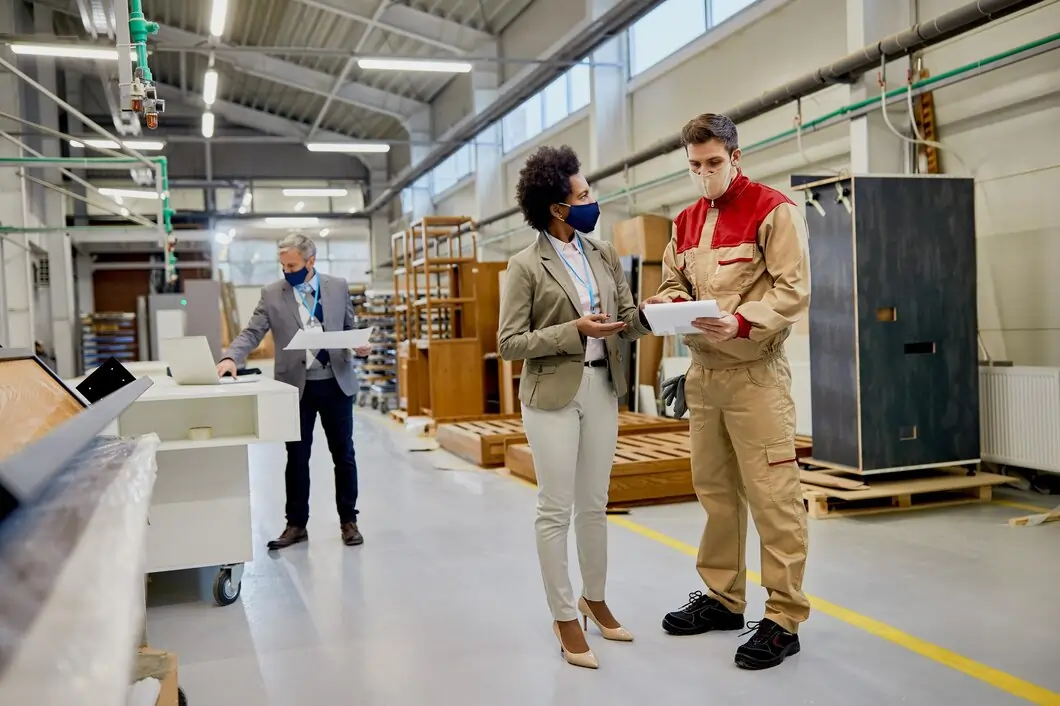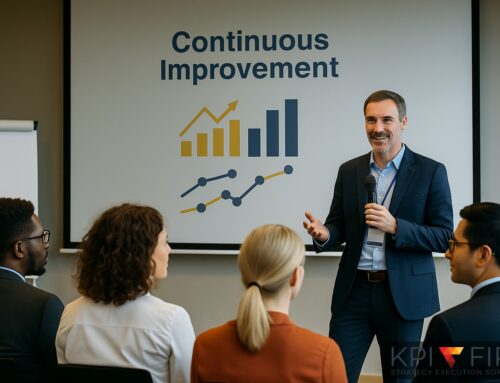Imagine stepping out of your office and into the heart of your company’s operations, witnessing firsthand how work is done, and engaging directly with the people who make it happen. That’s the essence of a Gemba Walk. More than just a casual stroll, it’s a powerful Lean management tool that puts leaders on the front lines, fostering continuous improvement and deeper understanding. In this blog, we’ll delve into Gemba Walk 101, exploring its definition, uncovering its myriad benefits, and providing a practical guide to implementation. Whether you’re a seasoned Lean practitioner or just beginning your journey towards operational excellence, understanding the Gemba Walk is crucial in understanding the common language of continuous improvement and driving meaningful change within your organization.
Main Takeaways From This Article:
- Gemba Walks are about direct observation and engagement: Leaders must physically go to the “Gemba” (the workplace) to truly understand processes, moving beyond reports and fostering employee interaction.
- Purposeful questioning is key: Asking “why” repeatedly helps uncover root causes of issues, promoting a culture of problem-solving and continuous learning.
- Respect and collaboration are essential: Gemba Walks should be collaborative, not critical, valuing employee expertise and building trust.
- Structured implementation drives results: Defining objectives, preparing, documenting, and following up are crucial for maximizing the effectiveness of Gemba Walks.
- Gemba Walks reveal hidden inefficiencies: Real-time observation uncovers waste and improvement opportunities that data reports often miss.
- Tools like KPI Fire enhance Gemba Walks: Mobile apps streamline documentation, action item management, and tracking, turning observations into tangible impro
What is a Gemba Walk?
The Gemba Walk is a direct, observational practice where leaders venture to the “Gemba”—the Japanese term for “the real place” where work is done. It’s about bypassing secondhand information and reports to experience processes firsthand. Rather than micromanaging, the goal is to observe, learn, and engage with employees, fostering a culture of continuous improvement through direct understanding.
The Purpose and Principles of Regular Gemba Walks
Regular Gemba Walks are essential for effective Lean management because they provide firsthand insights into operational realities, enabling leaders to identify improvement opportunities directly at the source. They bridge the gap between management theory and practical application, ensuring continuous improvement efforts are grounded in real-world observations.
Seeing Reality Firsthand
Management and leadership engaging directly with frontline employees moves beyond abstract reports and theoretical analyses. By physically observing processes at the Gemba, leaders gain a nuanced understanding of the daily workflow, revealing discrepancies between intended procedures and actual execution. For example, a production manager walking the factory floor might notice a recurring delay in material delivery, prompting an investigation into the supply chain. This direct observation is crucial for identifying improvement opportunities that are often invisible from a desk.
Engaging with Employees
Encouraging a two-way dialogue to understand pain points and challenges transforms Gemba Walks from passive observation to active collaboration. This engagement fosters trust and empowers employees to share valuable insights, leading to more effective problem-solving. A nurse manager, for instance, might learn from a conversation with a frontline nurse that a particular equipment layout causes unnecessary movement and delays patient care, leading to a redesign of the workspace. This direct feedback loop is essential for creating solutions that address real-world challenges.
Eliminating Wasteful Activities & Practices
Recognizing bottlenecks, redundancies, and opportunities for process improvements is a core objective of Gemba Walks. By observing the flow of work, leaders can identify and eliminate wasteful activities that hinder efficiency and productivity. For example, a warehouse supervisor walking through the shipping area might observe that redundant data entry is slowing down the dispatch process, leading to the implementation of automated data transfer. Identifying and eliminating these inefficiencies streamlines operations and improves overall performance.
Fostering Continuous Improvement
Creating a culture where feedback leads to real changes ensures that Gemba Walks translate into tangible improvements. When employees see their input being valued and acted upon, they become more engaged and motivated to contribute to ongoing improvement efforts. A retail store manager who regularly conducts Gemba Walks and implements employee suggestions for better customer service, for instance, might see a significant increase in customer satisfaction scores. This continuous feedback loop reinforces a culture of proactive problem-solving and sustained improvement.
The Three Key Elements of the Gemba Walk Process
To maximize the effectiveness of a Gemba Walk, adhering to three core principles is paramount: Go See, Ask Why, and Show Respect. These elements ensure that observations are thorough, understanding is deep, and a culture of collaborative improvement is fostered.
Go See
“Go See” emphasizes that leaders must physically visit the Gemba to witness processes firsthand, moving beyond reports and metrics. This direct observation allows for the identification of subtle inefficiencies and improvement opportunities that are often missed when relying on secondhand information.
Ask Why
Engaging with employees and asking “why” repeatedly is crucial to uncover the root causes of issues, rather than just addressing surface-level symptoms. This inquisitive approach fosters a culture of problem-solving and continuous learning, where teams are empowered to delve deeper and find sustainable solutions.
Show Respect
Gemba Walks should foster collaboration, not criticism, by acknowledging employees’ expertise and encouraging their participation. Leaders must demonstrate respect as the foundation of lean to build a culture of trust where employees feel safe sharing insights and contributing to improvements.
Types of Gemba Walks for a Fresh Perspective
Different types of Gemba Walks provide targeted insights into specific aspects of operations, enabling organizations to address diverse challenges and achieve varied strategic objectives. By tailoring the Gemba Walk to the specific goal, leaders can gain a fresh perspective and drive focused improvements.
- Daily Gemba Walk – Routine walks performed at the start of shifts to monitor progress and maintain standard work.
- Leadership Gemba Walk – Executives and managers engage with frontline teams to align strategy with real operations.
- Safety Gemba Walk – Dedicated to identifying hazards, enforcing safety protocols, and reducing workplace risks.
- Personal Gemba Walk – Individual employees observe their own workflows to spot inefficiencies.
- Customer Gemba Walk – Focuses on improving customer experience by assessing service quality and interactions.
- Vendor Gemba Walk – Conducted at supplier locations to ensure quality control and alignment with production needs.
- Impromptu Gemba Walk – Unscheduled visits that capture real-time process insights without prior preparation.
- Virtual Gemba Walk – Uses video calls or remote monitoring to observe operations when in-person visits aren’t feasible.
How to Conduct a Successful Gemba Walk
A structured approach to Gemba Walks is crucial for transforming observations into actionable insights and driving measurable improvements, ensuring that each walk contributes to the organization’s continuous improvement journey.
1. Define the Objective
Before venturing to the Gemba, clearly define the walk’s objective. This involves specifying whether the focus is on assessing efficiency, safety, quality, or another specific aspect of operations. A clear objective ensures that observations are targeted and relevant, maximizing the value of the walk.
2. Prepare and Communicate
Prior to the walk, inform employees about its purpose and scope, emphasizing that it’s a collaborative learning opportunity, not an evaluation or inspection. Transparency builds trust and encourages employees to openly share their insights. Communicating the objective in advance prepares employees and ensures they understand the walk’s intent.
3. Go to the Gemba (The Actual Workplace)
Physically go to the Gemba to observe work processes in real time, avoiding assumptions and taking detailed notes. Focus on the workflow, communication patterns, and potential problem areas, observing how work is actually performed, not how it’s documented. This firsthand observation is crucial for identifying hidden inefficiencies.
4. Engage with Employees & Ask Questions
Engage with employees by asking open-ended questions to understand their challenges from their perspective. Focus on questions like “What’s the biggest challenge you face in your daily tasks?” and “What improvements would make your job easier?”. This dialogue fosters a culture of collaboration and empowers employees to contribute to process improvements.
5. Identify Waste and Improvement Opportunities
While observing, actively look for inefficiencies, bottlenecks, unnecessary steps, and safety risks. For example, a warehouse manager might notice excess motion waste due to poorly organized inventory. Identifying these opportunities is about seeing where value is not being added, allowing for targeted process improvements.
6. Document Observations and Insights
Record key findings objectively, without immediately jumping to conclusions or solutions. Ensure that observations are data-driven and specific, focusing on what was seen and heard. This documentation provides a factual basis for future analysis and action planning.
7. Take Action & Follow Up
Collaborate with teams to create and implement action plans based on the documented findings. Track improvements over time to ensure continuous progress and reinforce a culture of continuous improvement. Regular follow-up ensures that the Gemba Walk translates into tangible, sustainable improvements.
Gemba Walk Checklist
This Gemba Walk checklist provides a structured framework to ensure that your observations are thorough and your insights are actionable, leading to effective process improvements. By following these steps, you’ll maximize the value of your Gemba Walks and drive continuous improvement within your organization.
- What are you doing now?
- Is there a standardized process for completion?
- If there is a process, is it being followed?
- Are you encountering problems while completing this task?
- What challenges do you face?
- What causes the problem?
- How do you find the root cause of a problem?
- What can you fix?
- What can’t you fix?
- Who do you contact if you need any help resolving a problem?
- Do you use a visual management tool?
- Is it useful? If not, why?
Benefits of Conducting Gemba Walks
Gemba Walks are a powerful tool for driving operational excellence by providing a direct window into real-time processes, fostering team collaboration, and uncovering hidden inefficiencies that traditional management methods often miss. They create a culture of continuous improvement by bringing leaders to the front lines.
Allow for In-Person Observation and Deeper Understanding
By directly observing processes, leaders gain a richer, more nuanced understanding of operational challenges than they could from reports alone. For example, a hospital administrator walking through the emergency department might observe firsthand the bottlenecks caused by a poorly placed supply station, leading to immediate adjustments. This direct observation provides context and reveals the “why” behind performance metrics.
Encourages Proactive Problem-Solving
Identifying inefficiencies in real time allows teams to address small issues before they escalate into major problems, fostering a culture of proactive problem-solving. For instance, a production team noticing a minor equipment malfunction during a Gemba Walk can fix it immediately, preventing a potential production shutdown. This empowers employees to take ownership and contribute to continuous improvement.
Enhances Cross-Functional Collaboration
Gemba Walks bring together diverse teams, fostering dialogue and alignment on process improvements. When a sales manager joins a Gemba Walk in the fulfillment center, they gain insight into order processing challenges, leading to improved communication and coordination between sales and fulfillment teams. This cross-functional interaction breaks down silos and promotes shared understanding.
Increases Employee Engagement and Ownership
When employees see leaders actively engaging with their work, it demonstrates that their contributions are valued, boosting morale and fostering a sense of ownership. For example, a retail store manager who regularly participates in Gemba Walks and implements employee suggestions for better customer service will see increased engagement from their employees. This direct engagement reinforces the importance of their work and their role in the organization’s success.
Identifies Hidden Inefficiencies and Wastes
Observing processes in real-time often reveals inefficiencies that are not apparent in data reports, such as unnecessary movement, waiting times, or redundant tasks. A manufacturing supervisor walking the production line might notice that workers are walking excessive distances to retrieve tools, prompting a reorganization of the workstation. These real-time observations highlight opportunities for streamlining processes and eliminating the 8 wastes of lean.
Using the KPI Fire App for Gemba Walks
The KPI Fire mobile app transforms Gemba Walks by enabling real-time documentation and action item management directly from the Gemba. With features like instant note-taking, photo uploads, and on-the-go task assignments, leaders can capture observations and insights as they happen, ensuring no valuable information is lost. This streamlined approach facilitates immediate follow-up, turning observations into actionable improvements efficiently.
Utilize Gemba Walks to Master the Continuous Improvement Process with KPI Fire
Gemba Walks are transformative for any organization committed to continuous improvement. By venturing directly to the “Gemba”—the place where value is created—leaders gain invaluable firsthand insights into operational realities. This direct observation reveals hidden inefficiencies, uncovers process bottlenecks, and fosters a culture of collaborative problem-solving. When leaders actively engage with employees on the ground, they demonstrate a genuine commitment to understanding and addressing their daily challenges. This not only boosts morale and strengthens employee engagement but also empowers teams to contribute directly to improving their work environment and processes. The real-time insights gained from Gemba Walks become the foundation for targeted, data-driven improvements.
KPI Fire supercharges the impact of Gemba Walks by providing a structured platform for capturing, managing, and acting on observations. With KPI Fire, leaders can document findings in real-time, assign action items, track progress, and ensure accountability. This eliminates the risk of valuable insights being lost or overlooked. The platform’s visual/executive dashboards and reporting tools offer a clear, comprehensive view of improvement initiatives, enabling teams to monitor progress, identify trends, and make informed decisions. By bridging the gap between observation and action, KPI Fire transforms Gemba Walks from isolated events into a powerful engine for continuous improvement, driving measurable results and fostering a culture of sustained excellence.
Ready to harness the full potential of Gemba Walks and streamline your continuous improvement efforts? Schedule a personalized demo of KPI Fire today and discover how our platform can empower your team to drive meaningful change and achieve your strategic goals.




